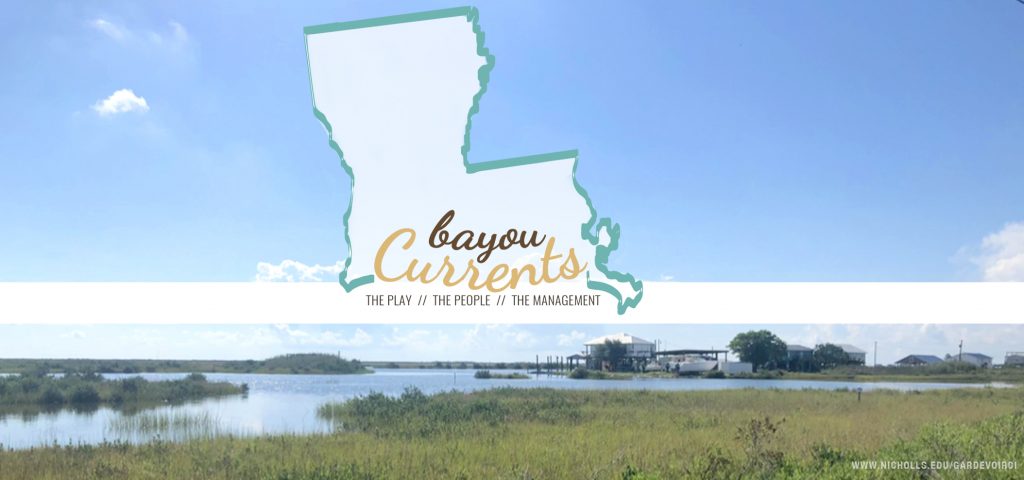Bayou Currents // The Region’s Most Influential Resource

by Kathleen Rodrigue, features editor Water. Locals along the South Louisiana coast, couldn’t escape it if they tried. Bayous, lakes and the Gulf of Mexico physically surround the region. Water is so common that residents, without even paying attention, cross bodies of water every day and use bayous and rivers to describe where they’re headed, instead of using cardinal directions. Water is everywhere. “We are sitting on top of a mountain of natural resources, almost all of which are related to the water,” says Michael Massimi, invasive species coordinator for the Barataria-Terrebonne National Estuary Program. This issue of Garde Voir Ci explores South Louisiana’s waterways and coastal land — how water has sustained the people who settled here, influences the region’s unique blend of cultures and provides locals with recreational activities. And, maybe most importantly, this edition will explore the threats to the coast and ways residents are working to protect their land and waterways. The region’s first beginnings are rooted in water. Bayou Lafourche, one of the main waterways in the Bayou Region, was the main channel of the Mississippi River and therefore the primary thoroughfare for commercial traffic, says Massimi with the Barataria-Terrebonne National Estuary Program. Due to this, Bayou Lafourche became the primary reason immigrants established their roots in South Louisiana. The French, Spanish, Germans, Cajuns, Creoles, Acadians, Anglo-Americans, Croatians and Vietnamese were among the first to arrive, drawn by the water, and are the basis for the region’s “interesting blend of cultures,” says Angela Rathle, Thibodaux’s supervisor park ranger. The Croatians were involved in the fishing and oyster industries, Acadians were farmers, and the Vietnamese contributed shrimping skills, she says. And the Europeans settled here in order to gain control over the Gulf of Mexico and the Port of New Orleans. “When you look at Louisiana, it’s all about the water… I think the more you study about this region, you see how important the rivers and bayous are to the development of people’s lives,” Rathle says. South Louisianans have always depended on the coastal region’s waterways. Not only does the water provide people with livelihoods, but it also shaped the recreational culture that still stands today. Henry Templet, treasurer of Friends of Bayou Lafourche, says fishing, crabbing, shrimping, boating, skiing, swimming, and even pirogue racing down Bayou Lafourche are a few pastimes locals enjoy. While the water has drawn people to the region and driven recreation and livelihoods, residents haven’t always taken care of the water and coastal lands. Coastal land loss is becoming a real problem as whole communities, like the Biloxi-Chitimacha-Choctaw Native American tribe living in Louisiana’s coastal wetlands, are now under water and, BTNEP’s Massimi says people are to blame for most of the land loss and poor water quality. “Louisiana residents just don’t seem to have the pride or respect for wilderness like people in other states have,” he says. “Nineteen hundred square miles of land have been lost between the 1930s and 2012. The amount of land loss we have experienced in those last 80 years is roughly equal to the amount of land we could lose in the next 50 years.” The biggest causes of coastal land loss are subsidence, or sinking land, salt-water intrusion, sea-level rises, coastal erosion, carving out canals, and invasive species. Massimi says it’s even more concerning that the region’s Barataria-Terrebonne National Estuary, the 4.2 million acres of land between the Atchafalaya River and the Mississippi River, is the “fastest disappearing landmass in the state, or possibly the world.” Land and water are changing so quickly that the effects are noticeable in one lifetime. “It’s been 26 years since I retired. I wouldn’t recognize that area, because so much of its land has gone and washed away by now,” says Leroy Lebouef, a retired production supervisor that worked for Texaco in Venice. Coastal organizations recognized this problem in the late 1970s and have been developing plans and executing projects since then to restore the land. Massimi says the Barataria-Terrebonne National Estuary Program created the Comprehensive Conservation and Management Plan and the Coastal Protection and Restoration Agency is the agency that creates a new Coastal Master Plan every 5 years. In order to continue restoring the coast, Alma Robichaux, BTNEP’s outreach coordinator, says people need to participate in coastal cleanup efforts, eliminate the use of plastics and have conversations with congressmen about the importance of having the funds to preserve Louisiana’s land. “We are sinking and the sea is rising at the same time. Louisiana is in a very precarious situation, so we need to act now.”
